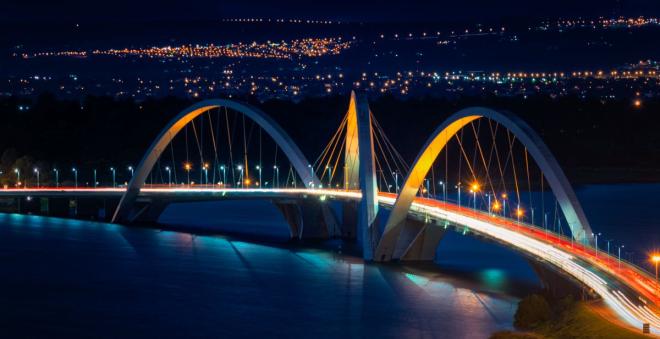5 Ways to Turn Streetlights into a Powerful Public Safety Technology

Streetlights play an important role in creating safer streets — whether by preventing traffic accidents or reducing crime. The well-documented impact of street lighting on driver behavior, pedestrian visibility, and criminal activity makes intelligent street lighting a critical public safety technology.
Poor lighting can cause glare and other effects that compromise road safety at night. More adaptive street lighting strategies have been shown to reduce fatal midblock crashes by over 50%, according to this New Zealand study by Jackett and Frith.
Cities have also seen a clear link between better lighting and lower crime rates. A 2025 SSRN working paper on Philadelphia’s citywide LED upgrade found a 15% decline in outdoor nighttime street crimes and a 21% reduction in nighttime gun violence. Similarly, a 2007 systematic review by the U.S. Department of Justice found an average 21% decrease in crime in areas with improved street lighting.
Memphis Mayor Jim Strickland said of a recent lighting upgrade: “We will be bringing much needed and significantly improved lighting to every neighborhood in Memphis with these new lights. No longer will criminals have safe harbor to operate under the cover of darkness.”
But what exactly does "improved" lighting mean in 2025? Based on the latest research, here are five best practices cities are using to turn street lighting into a smart public safety lighting system.
1. Brighter isn’t Always Better
About 20 years ago, cities in the U.S. northeast upgraded highway lights from high-pressure sodium (HPS) to LED. The change made lighting whiter and brighter — but also caused problems like glaring off snow.
Switching from HPS to LED isn’t just a hardware swap; LEDs have to be appropriately dimmed and fine-tuned to suit different environments.
Intelligent controls are essential. When residents in Davis, California, and Cambridge, Massachusetts, complained their lights were too bright, the cities had no controls — and had to replace entire systems. Today, adaptive lighting allows municipalities to fine-tune brightness dynamically, as discussed in this American Medical Association report.
2. Conditions Count
Most drivers know that visibility is worse at dawn and dusk. These transitions can impair reaction times. Static timers often get out of sync, but smart lighting adjusts in real-time — especially when paired with GPS-based synchronization to the Earth’s rotation.
Different roads demand different approaches. Highways need long-range visibility. Neighborhood streets require targeted lighting — especially at intersections. Interestingly, some non-uniform lighting can improve depth perception, aiding safety.
3. Public Safety Technology Should Protect Pedestrians
Pedestrian safety demands balanced lighting — not just on roads, but also on sidewalks. In cluttered city environments, extra light is often required.
Smart lighting systems allow cities to customize brightness for each pole, creating transitions between intersections and mid-blocks, ensuring visibility without over-lighting.
4. Smart Streetlights Help Prevent Crime
Smart streetlights, crime prevention, and 2025 priorities are closely linked. Improved lighting prevents crime. A systematic review by the U.S. Department of Justice found a 21% reduction in crime in areas with enhanced lighting. Additionally, a 2022 study summarized by NBER showed that smart lighting upgrades in New York City public housing led to a 60% decline in serious nighttime crimes.
Smart systems deter crime, increase neighborhood pride, and encourage community engagement. Key design choices include color rendering, spacing, and glare control — all programmable in modern smart lighting networks.
5. Fewer Outages = Safer Communities
Outages and flickering lights create dark zones, undermining safety. Smart sensors now alert managers instantly to failures, flickering, power surges, or pole damage.
Instead of relying on citizens to call in or crews to drive around at night, cities can use automated monitoring tools to reduce downtime and improve safety outcomes.
The Key: Smart Streetlight Controls
Designing with adaptive technology in mind — and deploying products like UbiCell® and UbiHub® — help cities reduce costs, lower greenhouse gas (GHG) emissions, and boost safety.
Municipalities upgrading lighting systems often do so for energy savings — but in 2025, public safety is an equal priority. And governments are stepping up:
Government is ready to invest
U.S. DOT SMART Grants (2024–2025)
The SMART Grants Program provides $100 million annually through 2026 — totaling $500 million over five years — for technology-driven transportation projects focused on safety, equity, and smart mobility, including adaptive lighting, connected vehicles, and sensor-enabled infrastructure. Learn more
Safe Streets and Roads for All (SS4A)
The SS4A program offers $1 billion annually through 2026 — totaling $5 billion over five years — to fund Vision Zero initiatives that reduce fatalities and serious injuries. Funding supports safety infrastructure projects, including adaptive street lighting and pedestrian safety upgrades. Learn more
USDOT RAISE Grants (2024)
The RAISE program provides $1.5 billion annually from 2022 to 2026 — totaling $7.5 billion over five years — for multimodal infrastructure projects prioritizing safety, equity, and sustainability. Eligible projects include lighting upgrades and pedestrian safety improvements. Learn more
Cities that integrate public safety lighting systems into smart city plans can access significant federal funding.
With the right planning, adaptive street lighting becomes more than infrastructure — it becomes a platform for safer, smarter, and more connected communities.

